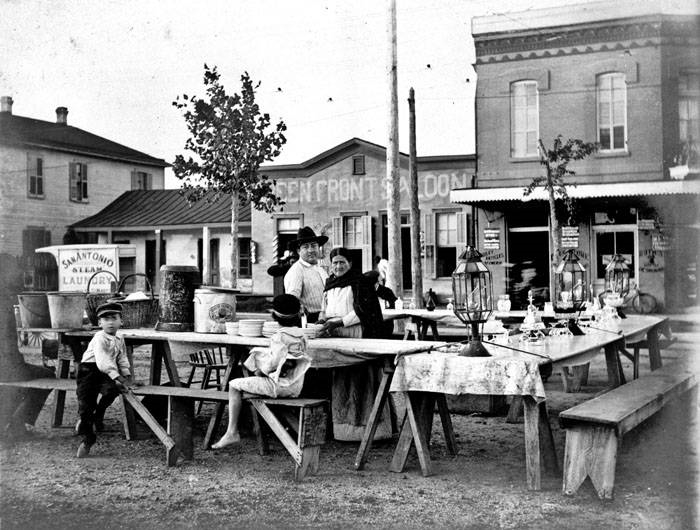Festive, Fun-Filled Kiwanis Fundraiser To Bring Bitesful Of Storied Winter Dish To Alameda On January 27th
Reader’s note: Please forward the link to this story to a friend! As a public service piece, this story does not require a subscription to ANN.
By Larry Freeman

The lore of Chili is thick and rich, and the lure of Chili again beckons Alamedans to ease their hankerings this month as The Alameda Kiwanis Club’s Annual Chili Cook Off returns to The Al Dewitt Officer’s Club on Saturday January 27th..
The Chili wizardry of this year takes the famed mainstay far beyond the realm of Chili dogs, Chili Fries and the various, mass produced canned brands lining grocery store shelves at $3 a pop or so.
Each of the five varieties of chili to be tasted will bring its own unique blend of spices, preparation and cooking techniques to deliver wide ranges of flavor, ‘heat’, consistency, the old beans/no beans or type of beans divide which span the range from smooth and easy soup-like creations to those that are hearty, rich, and stew-like .
This year’s version of the tasting is “Chili With A Twist,” due to a change in local health law and enforcement policy.
In the past local groups as the Alameda Fire Department, a team from Girl’s Inc. or chili-loving regular, hometown cooking folks doled out their creations, but this year a professional chef will do the honors.

Due to Alameda County Department Of Environmental Health rule and enforcement changes , local, non certified food handling entrants, –as this team of Alameda Firefighters from last year – are not allowed to participate without paying a hefty certification fee for inspection. Alameda Mayor Ashcraft is at far left
More picante? Less picante on the spice heat spectrum? It will all be there to tantalize and tickle anyone’s fancy and taste buds.
The fundraising event, now in its 22nd year, benefits a number of local community service, non profit organizations and begins at 5:30 pm at the nifty digs of the Al Dewitt “O” club, once the rarified, Officer’s Club sanctuary of U.S. Navy Officers when Alameda Point was an active U.S. Naval Base.
But for this event, Cowboy and Cowgirl get ups – instead of the officer’s uniforms of yesteryear– are the trending style option, in keeping with Chili’s Cowtown connections.
After a silent auction round, with adult beverages and soft drinks available to whet one’s whistles , the Chili tasting session –always an engaging schmooze and eclectic experience– will commence, as the heat is on to determine the top 2024 rendition.

The silent auction room transforms as everyone, tasting cups, spoons and chili choice ballot in hand, becomes a temporary culinary critic and purveyor of preference, advocating as to why one version ought to best another, as folks lobby or seek a second or third taste to break their own internal tie.
Following sampling comes a buffet dinner served up by The Texas Back 40 Barbeque outfit –a fitting tie to Chili’s reputed origin as a hearty dish with roots tied to San Antonio Texas as far back as 1828.
(To discover more about Chili’s fascinating back story, see “A Bowl Size History Of Chili” below)
With folks seated around the O’Club’s spacious dining room, dinner and more drinks flow along, and guests can purchase raffle tickets prior to a Western music dancing session and live auction to cap off the Chili, chicken, ribs and sides -fueled festivities.
Suspense always hangs in the air as voters wait to hear if their top chili choice takes an award.
Hoots and hollers will ring out after The “People’s Choice” rankings are announced, feeding self affirmation and the palate pride of those who sided with the majority.

This fundraiser is Kiwanis’ primary source to help support a number of Alameda community benefit organizations in 2024 as Meals on Wheels, Bay Area Music Program, The Alameda Boys and Girl’s Club and Girls Inc Of The Island City.
This is the club’s most important, not to mention entertaining and enjoyable fund raiser of the year, according to Denise Gasti, the club’s shaker-mover Secretary who has a knack for getting things done. “It supports so many important local organizations and really is a great example of the community coming together,” she said.
Community symbiosis combines in another important way as local enterprises chip in to sponsor the event.
This year’s top tier donors include, Black Stallion Estate Winery, Edward Jones by Dominic McKenna, Faction Brewing, Poppy Bank, and Becky Cusack, a fourth generation Alameda native, Alameda history buff and Broker with Eastside West.
This year, Alameda Kiwanis seeks to boost the amount of community grants to be awarded from $16,000 in 2019 to $20,000, and folks can help them reach or exceed that by sponsoring or donating (see below)
A many time attendee, Peg Kofman said that “I had a terrific time with friends and community members at the last event and appreciate the Kiwanis and all of the generous contributions they make towards helping others throughout the year.”
To become a sponsor or to donate, as tickets for the event just sold out, click here:
https://alamedakiwanis.org/ContactUs
======================
A BOWL-SIZED HISTORY OF CHILE, AN AUTHENTIC MEXICAN/TEXAS FOLK DISH
KNOW WHAT YOU’RE EATING, AND DON’T CALL IT “HASH’ !

By Larry Freeman alamedanews.org
Most of us know –or think we know– Chili in some capacity.
It’s that hefty, rich, red chili peppered brown sauce concoction that often calls to us on those cold winter meal times or just goes great as a belly-filling capper to a dog, burger a basket of fries at the ballpark or after a vigorous day on the slopes or coming in from ‘the back forty.’
Nourishing, smooth and often accentuated with beans, usually pinto, maybe beef, pork or turkey, and typically any of a number of other ingredients as chopped onion, tomatoes, and paprika.
Like a great beer brew, the dish is wide open to plenty of ingredient interpretation and amounts, that can involve bell peppers, black, kidney, great northern or kidney beans, corn kernels, bell peppers, coriander, garlic, cumin, habanero, jalapeno or other hot, “picante” peppers and even more for the bold Chili maker seeking to make the ultimate version and to determine just the right amount of ‘zing.’
But there is another, universal, key ingredient of Chili, in this case its savory backstory.
A largesse of lore, and even legend, spices up the story of Chili, conventionally thought to have originated in San Antonio Texas on or before 1828 when the territory was a part of Mexico, even though American settlers were horning in.
In that sense, the branding of Chili as a Tex/Mex concoction is actually in reverse order.
Authentically, based on its geographic origins, it ought to be Mex/Tex instead.
The naming of San Antonio as the seminal spot is based, in part, on a journal account from one “J.C. Clopper, ”a trader from Cincinatti who visited the town that would later become a flashpoint in American history when U.S. settlers attempted to take “The Alamo” from Mexico in the “Texas Revolution.”
In his 1828 journal, Clopper notes that what we now call “Chile Con Carne” (Chili with meat) was a common family dish born of scarcity and frugality. “ When they have to pay for their meat in market, a very little is made to suffice a family. It is generally cut into a kind of hash with nearly as many peppers as there are pieces of meat. This is all stewed together.”
Whether one likens Chili to a stew, a soup or a food phenom unto itself -as can be found in the variants of Chili Cook Offs around the country and elsewhere– we don’t ever associate it as a kind of hash, which sounds like quite another dish and on the dry side of the food moisture spectrum.
In fact, Chili as we commonly conceive it, did have a variant that was utterly dry, even more than “hash.”
As a low cost and nutritional food in an era when canned food was expensive and required special facilities, Chile became a type of dried fodder for soldiers.
A recipe dating back to the 1850s describes dried beef, suet, dried chili peppers and salt, which were pounded together, formed into bricks and left to dry, which could then be boiled in pots in an army encampment in Monterrey, of what is now Nuevo León, Mexico.
Texas, never to be outdone on big hat, big cattle claims to fame, continues its historic grip on the dish, with evidence found in the turn of the century writings of Everrette, a Dallas chili aficionado who claimed that ‘Americanized’ chili was created around 1850 by Texan adventurers and cowboys as a staple for hard times when traveling to and in the California gold fields.
. Needing hot grub, “the trail cooks came up with a sort of stew. They pounded dried beef, fat, pepper, salt, and the chili peppers together. This amounted to “brick chili” or “chili bricks” that could be boiled in pots along the trail. DeGolyer said that chili should be called “chili a la Americano” because the term chili is generic in Mexico and simply means a hot pepper. He believed that chili con carne began as the “pemmican (beef or dried meat jerkey) of the Southwest.”
Anyone for a “brick” of Chili?
It is not likely that those bricks were ever used to build prison or jail walls, but they did find their way into the gullets of convicts as well, which brings us to “The Chili Queens.”
Not royalty by any means, these women would cook up massive batches at home to take to market to sell as individual portions or directly to the buying public.
As for those behind bars and bricks of the real kind, Texas prison inmates had to stomach dollops of chili on a regular basis in what was termed as the Texas version of “gruel”, a stew of the cheapest available ingredients whose ‘con carne’ component was composed of finely hacked tough beef, chiles and spices boiled in water to an edible consistency.
No doubt, the peppers would help hide any rancidity or other untoward flavors and atmospheric emanations.
As to how Chili made it into the mainstream of the American diet beyond its primitive presenced in The West, we look to the “World’s Columbian Exposition of 1893” in Chicago which hosted a “San Antonio Chili Stand” run by a few select “Chili Queens.”
Chili Con Carne became quite the novelty for those who did not have to eat it out of money strapped, daily necessity or some other struggling lot in life.
The taste struck gold and became a new, sought after dining sensation that did find its way into the canned food industry and home pantries after a German immigrant, William Gephard visited near San Antonio and came up with a concoction known as Chili powder.
Gephart started canning Chile around 1908, and Gephart’s Chili set off a wave of competition from major packing and canning companies as Hormel, Dennison’s and others.
As for the seemingly very firm foothold of Texas and San Antonio’s residents from the early to mid 1800’s holding the claim to the original incarnation, don’t take full comfort as there is more to digest.
Alas, Chili isn’t just a food, it is a food debate among historians, one of whom is W.C. Jameson who offers eleven competing theories on the foodstuff’s origin.
Maybe food historian Rob Walsh has it right with his notion that 16 families of Canary Islanders who migrated to the San Antonio region came up with the dish as a delicacy as early as 1731 in their quest to become recognized business and political leaders of status and standng ,known as “hidalgos” or the “sons of something.”
Or maybe, and this is interesting food for thought, Chili comes from a 1568 account by Bernal Diaz del Castillo whose apocryphal tale relates that Aztect stewed Spanish Conquistadors as sacrifices, adding chile peppers, tomatos and spices. Of course it might have been a type of mole poblano and not Chili.
Then there is the option that Chili comes from the recipe of a Spanish Nun, Sister Mary of Agreda, whose spirit transported from her convent to West Texas’ Jumano native peoples who, in a visiion, gave her the recipe to combine venison, chile peppers tomatoes and onions into a stew.
So, just as it is with Chili and Chili cookoffs , you can take your pick of any of those offerings or go out and research others.
–Or, maybe not.
Maybe just quaff a swig of Modelo Negra with two twists of lime, and enjoy whichever version of the red brown delight suits you.
STORY BY Larry Freeman for Alameda Neighborhoods News Visit us at alamedanews.org
